Varieties of Electrical Wires and Cables
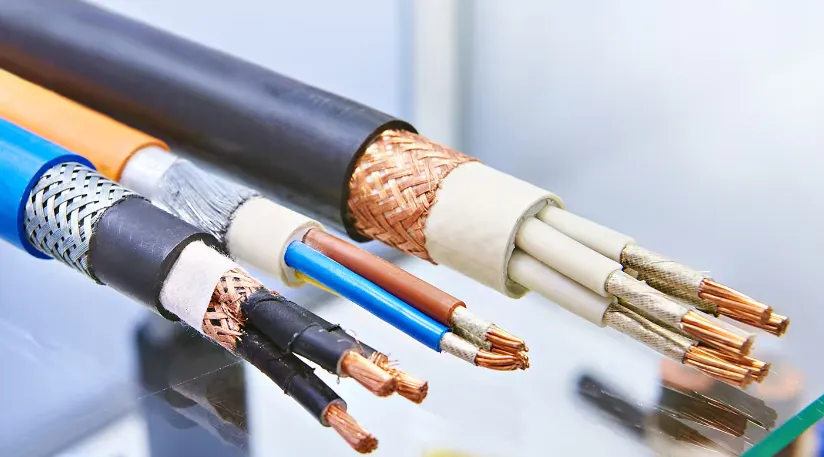
Different Types of Electrical Wires and Cables
Electrical cables and wires are often mistaken for the same entity; however, they have distinct differences. A wire comprises a single electrical conductor, while a cable constitutes multiple wires enclosed within a common sheath. Both serve the purpose of conducting electrical current.
In today's technological landscape, electricity fuels nearly every aspect of our lives. Whether indoors or outdoors, the requirement for a continuous and seamless supply of electricity necessitates the use of appropriate wires and cables. These components are vital not only in the electrical sector for power transmission to homes and industries but also play a critical role in the Telecom sector, enabling uninterrupted data transmission through various cable types.
Labeling of Cables
Accurate cable labeling holds immense significance as it offers comprehensive details about insulation types, wire counts, and wire gauges. Take a glance at typical labels found on wires commonly used in household wiring:
14-2G: Comprising two insulated wires and a ground wire, each wire is 14-gauge.
14-3G: Includes three insulated wires and a ground wire, each wire being 14-gauge.
12-2 w/G: Incorporates two insulated wires with a ground wire, each wire being 12-gauge.
12-3 w/G: Contains three insulated wires with a ground wire, each wire at 12-gauge.
600 V: Rated for a maximum of 600 volts, commonly employed as NM cable in household wiring.
TYPE NM-B: NM denotes Non-metallic, presenting a non-metallic sheathed cable of type-B, extensively used for wiring appliances and devices in homes.
Among these labels, the insulation type or plastic coating around the conducting wires holds paramount importance. Here are some frequently encountered labels indicating insulation:
THHN
THWN
THW
XHHN
Each letter in the labels carries specific meaning:
T: Thermoplastic insulation, providing fire resistance.
H: Heat-resistant, capable of enduring temperatures up to 167 F.
HH: Highly heat-resistant, withstanding temperatures up to 194 F.
W: Suitable for damp and wet areas, also viable for dry locations.
X: Insulated with a synthetic polymer that is flame-retardant.
N: Nylon-coated, resistant to oil and gasoline.
Residential Wiring Cables
Residential wiring, spanning from the utility pole to the household appliances or devices, typically falls into five primary categories:
Service Drop Cable
This cable connects the utility pole to the consumer's premises or building. Functioning as an overhead electrical line, it extends from the pole to the service weatherhead of a residence. Various types of service drop cables are available, including:
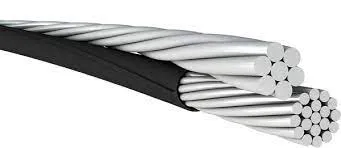
Duplex Cable:
The duplex service drop cable comprises two core conductors, consisting of an insulated conductor for the phase line and a bare conductor for the neutral line. Its purpose is to supply single-phase power to a building.
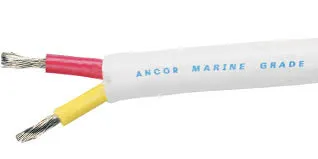
Triplex Cable
The Triplex service drop cable encompasses three core conductors, including two insulated conductors for the phase lines and a bare conductor for the neutral line.
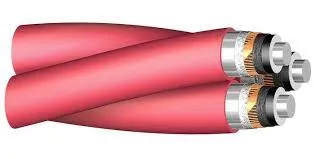
Quadruplex Cable
The Quadruplex service drop cable features four core conductors, consisting of three insulated conductors for the phase lines and a bare conductor for the neutral line. It serves the purpose of supplying a 3-phase power system from the utility pole to the building.
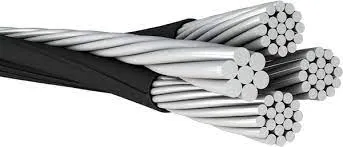
The phase conductor typically consists of an AAC cable, while the neutral conductor is available in options like AAC, AAAC, or ACSR. These cables are insulated with XLPE to safeguard the conductors against moisture and heat.
Main Feeder Wires
These wires facilitate power transmission from the service weatherhead to the building. Typically, 600v THHN cables, either solid or stranded, are employed for this purpose, rated at 25% higher than the maximum required load.
Panel Feed Wires
Panel feed wires deliver power to the primary distribution junction box. Usually, these are black-insulated THHN cables with a rating 25% higher than the maximum load current.
Non-Metallic Sheathed Wires
Non-metallic (NM) sheathed wires are utilized for internal household wiring. They may comprise 2 or more insulated conductors alongside an insulated or bare ground conductor, further protected by an additional layer of plastic XLPE sheathing. Presently, electricians favor the latest NM type-B version for interior installations. The conductors can be either solid or stranded, with stranded conductors being easier to thread through conduits.
Single Conductor Wire
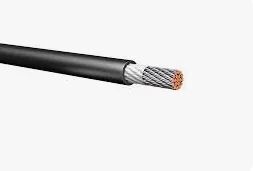
The preferred option for internal electrical layouts within homes, single conductor wire offers versatility. It comes in various gauges, colors (to distinguish phase, neutral, and ground), and options of solid or stranded conductors. Opting for a single solid wire ensures stronger connections, while single stranded wires are more easily maneuverable through conduits. Both variations are available with THW and THHN insulation options.
Varieties of Cables and Wires
Cables and wires come in diverse types, each tailored for specific applications and functions.
Communications Cable
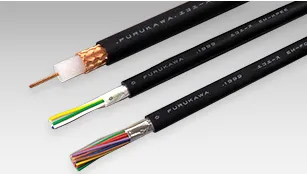
This category encompasses cables and wires dedicated to communication or signal transmission purposes, solely designed for relaying information. Among these are three prominent types:
Coaxial Cable
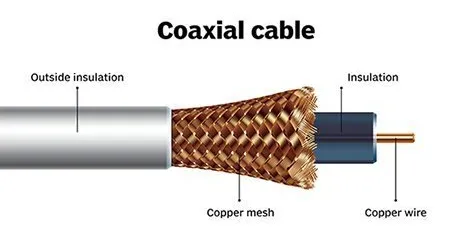
A coaxial or coax cable is an electrical cable featuring four layers arranged in a coaxial shape, sharing a common axis or center. Its core comprises a conductor insulated by a layer of plastic, enclosed by a metallic shield, and further covered by a fourth layer of plastic insulation.
Coaxial cables excel in transmitting high-frequency signals, utilizing the metallic shield to counteract noise interference. Widely employed for distributing cable television signals, linking antennas, transmitters, and receivers, these cables also come in various types, each tailored to specific applications.
Hardline Coaxial or Heliax Cable
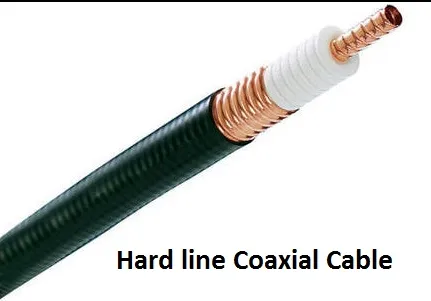
Renowned by its trademark name "Heliax," hardline coaxial cable stands out as a robust, thick cable featuring a solid copper center conductor and a shield composed of copper or silver tubing. Specifically engineered for high-frequency broadcast transmission, this cable is capable of carrying numerous channels. Typically, it is installed between a ground-based transmitter and an aerial antenna.
Radiating or Leaky Coaxial Cable
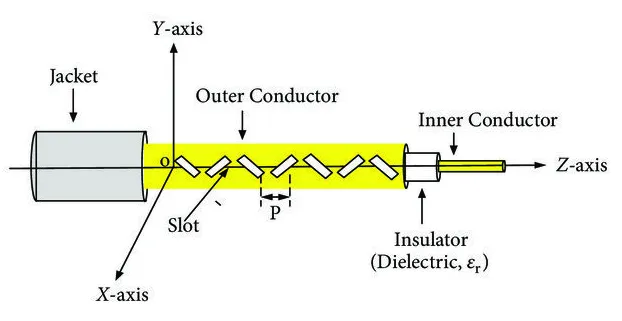
Another variant within the coaxial cable family, radiating or leaky coaxial cable, is purposely engineered with a shield designed to emit RF waves. The shield comprises slots precisely tuned for specific RF wavelengths, fostering a bidirectional leakage effect between the transmitter and receiver. This specialized coaxial cable finds application in areas where installing an antenna is impractical, such as underground tunnels or elevator shafts.
RG-6 Coaxial Cable
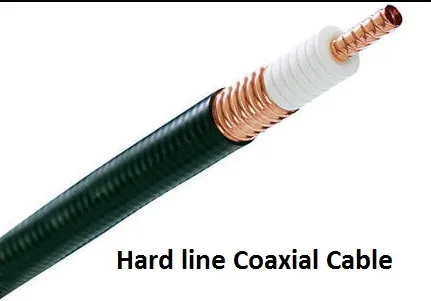
Among the prevalent coaxial cable varieties, RG-6 stands as the most widespread choice for signal transmission across residential and commercial settings. Constructed from a solid copper wire enveloped by plastic insulation, it features an aluminum foil and a braided shield, serving as a safeguard against interference.
Primarily utilized for transmitting audio and video signals, RG-6 finds application in cable TV, Satellite TV signals, radio transmissions, and similar uses.
Triaxial or Triax Cable
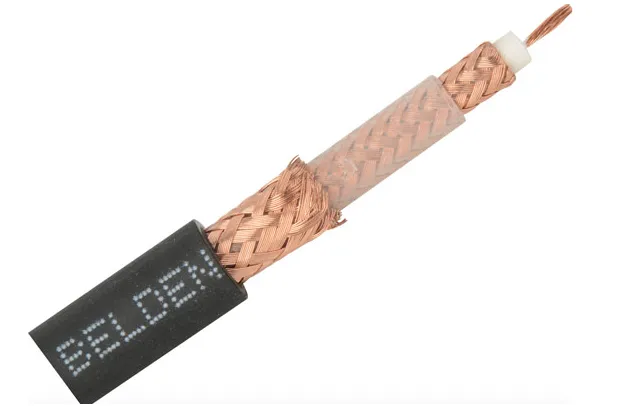
Triaxial cables are a variant of coaxial cables, featuring an additional layer of insulation and shielding atop the existing shield. The secondary or outer shield is grounded to safeguard the inner shield from electromagnetic interference.
Twin-axial or Twinax Cable
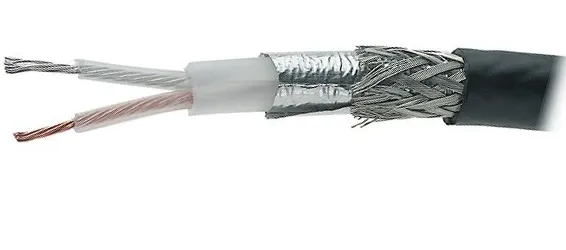
Twinax cables are coaxial cable types akin to RG-6 but distinguished by having two inner conductors instead of one. These insulated inner conductors are intertwined and encased within a braided shield. Primarily employed for high-speed, short-range signal communication, they are commonly used in 10 Gigabit Ethernet Networks.
Semi-rigid Coaxial Cable

Semi-rigid coaxial cables present another variant where the outer sheath comprises solid copper encasing an inner conductor. This robust outer shield significantly enhances interference protection. However, owing to its tube-like structure, it lacks flexibility and isn't intended for bending after its initial shaping.
Twisted Pair Cable

Twisted pair cables are fashioned from two insulated wires entwined to form a twisted pair. This method of twisting is instrumental in reducing electromagnetic interference or noise. These cables are commonly deployed in Ethernet networks and telephone communications.
They are further categorized based on their noise protection:
Unshielded Twisted Pair (UTP) Cable
_cable.webp)
UTP cables lack additional shielding against noise interference. While the twisted pairs mitigate noise to some extent, external disturbances can still impact transmission. Different categories of UTP cables, such as CAT1, CAT2, etc., find usage in residential and commercial buildings with varying bandwidth capabilities.
Shielded Twisted Pair (STP) Cable
STP cables incorporate an additional foil layer that shields the wires from electromagnetic interferences. These cables find application in high-end scenarios where external environmental interferences might affect cable performance.
Fiber Optic Cables
Fiber optic cables, also known as optical fiber cables, belong to the realm of communication cables and are constructed from flexible, transparent glass fibers—optical fibers—designed for data transmission in the form of light. Each individual fiber, with a thickness comparable to human hair, is enveloped in plastic insulation. Moreover, an external protective layer shields the fibers from interference.
Fiber optic cables are generally classified into two primary types:
Single Mode or Mono-mode Fiber Optic Cable
This cable exclusively permits a single mode of light transmission. Comprising a very slender single strand of fiber, it permits only one light wave to propagate, thereby reducing light reflection and minimizing signal attenuation. It offers high transmission rates over long distances with minimal attenuation, albeit at a higher cost.
Non-Metallic Sheathed Cable (NM, NM-B), also recognized by the trademark name "Romex," represents an electrical cable type encased in plastic for safeguarding its internal conductors. Commonly employed in residential electrical wiring, it offers insulation and protection.
There exist two classifications of NM sheathed cable based on the number of conductors:
Two-wire NM Sheathed Cable
This variant comprises two separately insulated conductors alongside a bare conductor designated for grounding, amounting to a total of three conductors. Available in various gauges catering to different ratings, its labeling typically appears as "<gauge> - 2 WG," signifying the cable contains two wires plus a grounding wire.
Three-wire NM Sheathed Cable: This variant comprises three insulated wires alongside a bare grounding wire, specifically designed for three-phase applications. Each individual conductor is marked with distinct phase colors for identification. NM wires are available in both solid and stranded forms. Solid conductors offer superior connections at terminals, whereas stranded conductors are more flexible, facilitating easier routing through conduits, albeit challenging in terminal connections.
NM-B (Building) Cable: NM-B, a specific type of NM cable, is primarily used for indoor building wiring. Ideal for wiring inside walls and floors, it is not recommended for use in damp or wet locations, such as external wiring setups.
Metallic Sheathed Cable (Armored Cable, AC or BX, MC): Metallic sheathed cables feature a protective metallic layer over insulated conductors. These conductors are individually insulated with a plastic layer, enveloped by a metallic sheath for added protection. The metallic sheath can be either braided, twisted, or in the form of a solid pipe-like structure.
Armored Cable (AC): This category of metallic sheathed cables includes a protective twisted or braided metallic layer, typically crafted from steel, surrounding the conductor. Encased in a plastic external sheath, these cables offer enhanced mechanical strength against potential damage and can serve as grounding connections. However, they are unsuitable for damp, wet, or underground locations due to the risk of corrosion. The armored layer can comprise wire braid, steel wire, or steel tape, with the steel wire armored (SWA) cable being a prevalent choice for power transmission.
Metal Clad (MC) Cable
MC Cable differs from AC cables in that its metallic sheath cannot serve as a grounding wire. Instead, it features an additional green-colored insulated wire designated for grounding. This distinction enables its usage in direct burial and wet locations, provided it retains its protective PVC outer sheath. However, metallic sheathed cables, including MC, are expensive, challenging to route, and require specialized tools for cutting compared to NM cables, which remain the preferred choice for residential wiring. They find application in powering large appliances and outdoor installations.
Multi-Conductor or Multicore Cable
These cables feature multiple conductors with individual insulated sheaths enclosed within a single jacketed cable. Their purpose is to streamline connections, replacing numerous separate wires with one cable. Often, these conductors include an aluminum layer for protection against electromagnetic interference (EMI) or an additional armored layer. Multi-core cables commonly terminate in a multi-pin connector, catering to various connections. They are extensively utilized in electronics for data transmission, such as audio signal transmission, gaming consoles, cameras in TV studios, and networking setups.
Paired Cable
Paired cables consist of two insulated conductors covered by an insulating sheath. Primarily used in DC applications and low-frequency AC applications, they serve various electrical purposes.
Portable or Extension Cord
Flexible and equipped with connectors at both ends, these cables supply temporary AC power. They serve as extensions for powering portable equipment, machines, and devices.
Ribbon Cable
Constructed from multiple small insulated wires arranged parallelly in a flat shape resembling a ribbon, ribbon cables offer flexibility and handle low voltages. Commonly used in electronic devices and computers, they connect internal peripherals such as hard drives, CD drives, and printers. Their flat design, however, obstructs airflow within computers, affecting cooling systems, leading to their replacement by round cables in modern applications.
Shielded or Screened Cable
Shielded cables incorporate an additional metallic layer—shield—to protect conductors from electromagnetic interference (EMI). This shield can be made from various metals like aluminum or copper, in the form of foil, tape, or a solid layer. Grounding the shield at one end eliminates EMI, essential in power cables to prevent corona discharge-induced insulation breakdown and electrical shocks.
Single Conductor Wire
Single conductor wire, commonly referred to as wire, comprises a single insulated conductor and is widely used in residential wiring. Available in multiple colors for phase and earth identification, it is categorized as single stranded or single solid wire. Single stranded wires, made of multiple thin strands, offer flexibility, ideal for bending or twisting applications, whereas single solid wires provide better connections but lack flexibility and are prone to damage through repeated bending.
Submersible Cable
Designed for wet or submerged environments, these rugged cables feature durable insulation. Available in single or multiple conductor designs with flat or round structures, they are color-coded for phase, earth, and control connections. Widely used in restricted or inaccessible locations, such cables power submersible motors and pumps in agricultural, mining, or drilling operations underwater.
Twin-lead
Utilized as a balanced line for radio frequency (RF) signal transmission, twin-lead cables feature two conductors held apart by a plastic layer. Equal spacing is crucial to prevent signal distortion, although these cables are more prone to external noise interference and weather conditions compared to coaxial cables.
Ladder Line
To prevent water accumulation and signal interference due to wet conditions, ladder line cables incorporate slots, creating a ladder-like structure. Available in different impedance values, such as 300 ohms for television sets, they connect transmitters or receivers with RF antennas in TV and radio setups.
Underground Feeder (UF) Cable
Designed for damp locations, UF cables feature individual conductors surrounded by a solid layer of thermoplastic for flexibility and added protection. Often used in supplying power to lamp posts or garden sheds, these cables are suitable for underground installations, avoiding exposed wiring or poles.
Flexible Cables
Engineered for continuous bending in moving applications, flexible cables utilize stranded conductors for flexibility. Available in two types—stranding in layers or stranding in bundles—they serve automation industries where machines undergo continuous movement, such as pick-and-place machines and CNC-based equipment.
Overhead Power Line
Conductors suspended from electrical towers or poles for long-distance power transmission fall under overhead power lines. These bare conductors, typically made of aluminum, possess varying electrical and mechanical properties based on construction.
All Aluminum Conductor (AAC), All Aluminum Alloy Conductor (AAAC), Aluminum Conductor Steel-Reinforced (ACSR), and Aluminum Conductor Aluminum-alloy Reinforced (ACAR):
These cables serve power transmission purposes with varying mechanical strengths, conductivities, and resistances to corrosion. AAC, AAAC, ACSR, and ACAR cables cater to different needs, spanning short-distance station setups to rural long-distance power transmission.
Bundled Conductors
Utilized to reduce corona discharge in high-voltage transmission lines above 132KV, bundled conductors feature two or more conductors per phase, separated by spacers to mitigate signal distortion and power loss due to ionized air around the conductors.
Wirewound Resistor: An In-Depth Overview
What are Lighting Ballasts?
How Does a Voltage Regulator Work? [Completely Explained]
Regulated vs Unregulated Power Supply: What's the difference?
Differences Between FPGA vs Microcontroller
Flexible Sensor Complete Guide
How does an Accelerometer Work?
What are Proximity Sensors ?
TXS0104EPWR Review: Features, Specification, and Applications
LR44 Battery: Everything You Need to Know [2024 Updated]










